Aardonyx Guide:
Aardonyx was an early dinosaur that lived in South Africa about 200 million years ago.
Aardonyx was an early dinosaur that lived in South Africa about 200 million years ago.
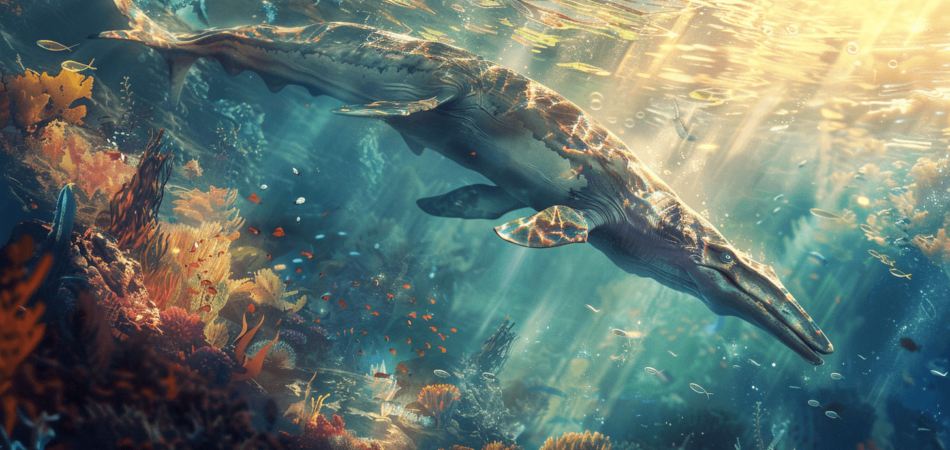
Elasmosaurus roamed the Western Interior Seaway during the Late Cretaceous period, intriguing scientists with its unique physique. Discovered in 1867 by Theophilus Turner, its features, such as a 25-foot long neck containing 71 vertebrae and sharp teeth, pinpoint its identity as a formidable marine predator. This reptile deftly swam with four flippers, suggesting a lifestyle capable of long-distance migration in search of prey or mating. Its diet mainly included small fish and invertebrates, utilizing its long neck for an ambush strategy. Further explorations into Elasmosaurus reveal fascinating insights into its life and the prehistoric oceans it inhabited.
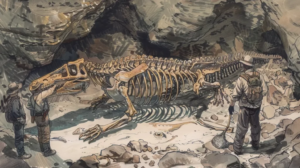
One’s understanding of prehistoric marine life took a monumental leap forward in 1867 when Theophilus Turner unearthed the first Elasmosaurus fossil near Fort Wallace, Kansas. This historical discovery marked the beginning of an era in fossil collecting that would vastly enrich our knowledge of ancient creatures. The Elasmosaurus, a long-necked plesiosaur that once roamed the prehistoric seas, became a subject of fascination and study.
Edward Drinker Cope, a prominent figure in the field, was instrumental in describing and naming the Elasmosaurus in 1868. His work laid the foundation for recognizing the Elasmosauridae family, characterized by their distinct long-necked plesiosaur traits. Cope’s dedication to paleontology and his keen interest in the Elasmosaurus specimen from Kansas highlighted the significance of this discovery in understanding prehistoric marine ecosystems.
The genus Elasmosaurus, established based on the initial specimen, represented a significant addition to the paleontological community. Fossils of this remarkable creature have since been found in various locations, including Kansas, Montana, and Alaska, broadening our understanding of its distribution and habitat. The initial find near Fort Wallace not only marked a pivotal moment in paleontological history but also underscored the importance of fossil collecting as a means to uncover the mysteries of ancient life.
Edward Drinker Cope’s work and the discovery of Elasmosaurus have left an indelible mark on the study of prehistoric marine life, revealing the diversity and complexity of creatures that inhabited the earth millions of years ago.

Elasmosaurus possessed a remarkably long neck, measuring about 25 feet, which featured 71 vertebrae. This extraordinary adaptation allowed it to have an extensive reach in the marine environment, positioning it as a formidable predator. The neck wasn’t just long but was supported by a complex structure of vertebrae, enabling it to move with agility and precision underwater. Its skull, though relatively flat, housed sharp, long teeth, perfect for catching slippery prey. These teeth, including six per premaxilla, were vital for its survival, allowing it to grasp and hold onto its meals with ease.
Moreover, Elasmosaurus was equipped with four flippers, a design marvel that speaks volumes about its marine adaptation. These flippers, reminiscent of those found in modern sea turtles, facilitated efficient swimming, steering, and maneuvering through the ancient seas. The creature’s long tail, comprising at least 18 vertebrae, played a pivotal role in its movement as well. It provided additional propulsion and stability, enabling Elasmosaurus to glide gracefully through the water.
The physical characteristics of Elasmosaurus, from its neck vertebrae to its long teeth and flippers, all contributed to its success as a marine predator. Its long tail further enhanced its swimming capabilities, making it a master of its aquatic domain. This unique combination of features underlines the remarkable marine adaptation of Elasmosaurus, showcasing the evolutionary marvels of the ancient world.
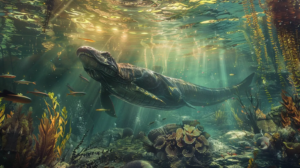
During the Late Cretaceous period, Elasmosaurus thrived in marine environments, primarily feeding on small fish and marine invertebrates. This ancient marine reptile’s habitat stretched across what was then the Western Interior Seaway, a vast expanse of water that divided the continent of North America. The seaway provided a rich variety of prey, making it an important habitat for Elasmosaurus, which utilized its long neck to ambush prey with surprising agility.
The diet of Elasmosaurus consisted mainly of fish and various marine invertebrates. Its lengthy neck, comprising 72 vertebrae, wasn’t just an extraordinary feature but a highly significant tool in hunting. This unique adaptation allowed the Elasmosaurus to reach into tight spaces among underwater vegetation and rocks to snatch unsuspecting prey. The flexibility and reach of its neck would’ve been vital in a marine habitat where agility and precision are key to survival.
Moreover, the Elasmosaurus was equipped with paddle-shaped flippers that enabled it to navigate through its aquatic environment with ease. These flippers produced wing-like movements, propelling the creature through the water in search of food. It’s suggested by researchers that these marine reptiles covered long distances in their quest for food and suitable breeding grounds, indicating a nomadic lifestyle within their marine habitat.
Understanding the habitat and diet of Elasmosaurus offers insight into the life of this fascinating creature. Its adaptations not only highlight its role within the marine ecosystem but also underscore the complexity and diversity of prehistoric marine life. Elasmosaurus, with its long neck and streamlined body, was well-suited for navigating the ancient seas, preying on smaller fish and cephalopods. This adaptability parallels the traits seen in the iguanodon dinosaur characteristics, showcasing the various evolutionary paths that different species took in their respective environments. By studying such creatures, we can appreciate the intricate relationships within marine ecosystems and the shared traits that reflect their lifestyles.
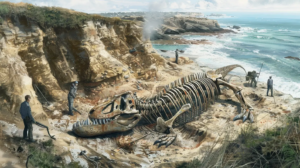
Several fossil discoveries across North America have shed light on the elusive Elasmosaurus, revealing intricate details about its physiology and lifestyle. The initial discovery in Kansas in 1867 by Theophilus Turner marked a noteworthy milestone in paleontological studies, bringing the first pieces of the puzzle to the scientific community. This groundbreaking find, later named Elasmosaurus platyurus by Edward Drinker Cope in 1868, opened the floodgates for further research and fossil finds.
Subsequent excavations in Montana and Alaska have enriched our understanding of this ancient marine reptile. Each fossil find has contributed valuable information, piecing together the life and environment of the Elasmosaurus. Its long neck, characterized by an astonishing 72 vertebrae, has been a focal point of fascination, offering clues to its feeding habits and maneuverability in the marine ecosystems of the Late Cretaceous period.
The holotype specimen, ANSP 10081, encompasses fragmentary skull, spine, pectoral, and pelvic girdles, providing a tangible connection to the past. This specimen serves as the benchmark for identifying and categorizing Elasmosaurus remains, ensuring that each new discovery is accurately interpreted and understood within the broader context of Elasmosaurid research.
These fossil finds haven’t only illuminated the physical attributes of the Elasmosaurus but have also painted a vivid picture of its lifestyle. They’ve enabled scientists to reconstruct its habitat, dietary preferences, and evolutionary history, notably advancing our knowledge of prehistoric marine life. Through these discoveries, the Elasmosaurus has emerged from the depths of history, capturing the imagination of scientists and enthusiasts alike.
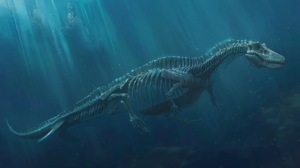
Delving into the anatomy of Elasmosaurus reveals a creature perfectly adapted for its aquatic lifestyle, with a markedly elongated neck and specialized flippers for swimming. Its streamlined body complemented by a long tail, enabled this prehistoric marine reptile to glide through the waters of the Late Cretaceous period with ease. The sharp teeth and impressive reach of its long neck made Elasmosaurus a formidable predator, capable of ambushing prey in a sudden and swift manner.
The four flippers of Elasmosaurus played a pivotal role in its swimming capabilities, allowing for powerful and precise movements in the marine environment. This unique combination of anatomical features underscores the specialized nature of Elasmosaurus as an aquatic predator, adept at exploring the ancient seas in search of food.
| Feature | Description | Impact on Lifestyle |
|---|---|---|
| Long Neck | 25 feet long with 71 vertebrae | Enabled ambushing prey |
| Sharp Teeth | Long, sharp, including six teeth per premaxilla | Effective at capturing prey |
| Four Flippers | Specialized for swimming | Enhanced maneuverability |
| Streamlined Body | Designed for efficient movement through water | Facilitated swift swimming |
| Long Tail | At least 18 vertebrae, aiding in propulsion | Assisted in agile swimming |
The anatomy of Elasmosaurus not only paints a picture of a highly adapted marine predator but also evokes a sense of wonder at the evolutionary paths taken by life on Earth. Understanding these anatomical insights allows us to appreciate the complexity and diversity of prehistoric marine ecosystems.
Building on the understanding of Elasmosaurus’s anatomy, it’s important to explore how this ancient marine reptile fits within the broader context of species classification. Known for its distinctive long neck and a remarkable number of neck vertebrae, Elasmosaurus has intrigued scientists and paleontology enthusiasts alike since its discovery in the 19th century. Belonging to the genus of plesiosaurs, its unique features have played a pivotal role in its classification within the prehistoric world.
The type species,Elasmosaurus platyurus, stands out as a singularly unique species among plesiosaurs, mainly due to its extensive neck vertebrae, which surpasses that of any known plesiosaur species. This characteristic, combined with its streamlined body and paddle-like limbs, has cemented its place within the species classification of ancient marine reptiles. Initially, various species were attributed to Elasmosaurus by Edward Drinker Cope, the paleontologist who first named it. However, over time, some of these attributions have been reclassified or considered dubious, narrowing the focus to the distinctive features of the type species itself.
Elasmosaurus is classified under the family Elasmosauridae, a group characterized by elongated necks and specialized anatomy tailored to a marine lifestyle. The establishment of the genus Elasmosaurus marked a significant milestone in paleontological studies, providing a clearer understanding of the diversity and specialization among plesiosaurs. This classification not only highlights the unique adaptations of Elasmosaurus but also reflects the complexity of prehistoric life in Earth’s oceans.
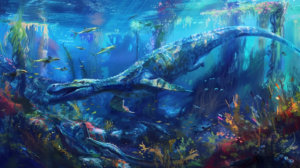
Elasmosaurus’s distinctive anatomy played a pivotal role in its survival, enabling it to adapt effectively to life in the ocean’s depths. This prehistoric marine reptile, with its long neck and streamlined body, was a master of the aquatic domain. Its physical adaptations were vital for traversing the vast, open waters it called home.
The elongated neck, consisting of an astonishing 72 vertebrae, wasn’t just for show. It allowed Elasmosaurus to ambush its prey with a stealth and precision unmatched by many of its contemporaries. By concealing its body in the murky depths, it could thrust its neck forward with surprising speed to snatch up fish and marine invertebrates. This strategy of ambushing prey highlights the cunning behavioral adaptations that aided in its success as a predator.
Moreover, Elasmosaurus’s swimming capabilities were markedly enhanced by its paddle-shaped flippers. These flippers enabled it to execute wing-like movements in the water, propelling itself with efficiency despite its large size. This adaptation was essential for both hunting and long-distance migrations to breeding grounds, indicating a lifestyle that required both power and stamina.
The combination of these physical adaptations—its neck for ambushing prey and flippers for swimming—demonstrates the specialized nature of Elasmosaurus’s behavior in its ancient marine environment. These traits not only facilitated its hunting strategy but also guaranteed its survival in the competitive ecosystems of the Late Cretaceous period. Through these adaptations, Elasmosaurus exemplified the intricate relationship between form, function, and behavior in the prehistoric world.
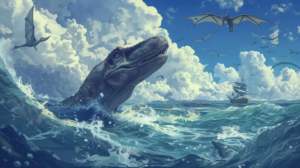
Among the many intriguing aspects of Elasmosaurus, its portrayal in popular culture and its connection to modern myths stand out. This prehistoric marine reptile, with its distinctive long neck and streamlined body, has captured the imagination of people around the world. Paleontologists have worked diligently to piece together the life of Elasmosaurus, debunking myths and providing scientific insights into its existence.
One of the most enthralling anecdotes involves the misconception that Elasmosaurus could coil its neck like a snake. This image, perpetuated by early reconstructions and fictional portrayals, has since been corrected by experts who emphasize the physical limitations of its vertebrae. Despite this, the image of a snake-like neck persists in some circles of popular culture, illustrating the gap between scientific understanding and public perception.
Elasmosaurus’s appearance on the TV show ‘Sea Monsters’ further solidified its place in the world of popular culture. The show, which explores the lives of ancient marine creatures, brought the Elasmosaurus to life for viewers, showcasing its hunting prowess and unique physical characteristics, such as its long neck and sharp teeth.
Perhaps the most fascinating connection is the comparison between Elasmosaurus and the Loch Ness monster, Nessie. Many enthusiasts and conspiracy theorists have proposed that Nessie could be a surviving Elasmosaurus or a similar species. While there’s no scientific evidence to support this claim, it demonstrates the lasting impact Elasmosaurus has had on popular culture and modern myths, bridging the gap between prehistoric life and contemporary imagination.
Peering into the depths of time, scientists reveal the age of Elasmosaurus fossils through radiometric dating, a method that’s both precise and enlightening. They measure the decay of isotopes in surrounding sedimentary rock, providing reliable timelines.
Additionally, relative dating places fossils in a chronological sequence by examining their positions in sediment layers. This blend of techniques offers a clear window into the ancient past, revealing when these majestic creatures roamed the seas.
Paleontologists face significant challenges in reconstructing the skin color and texture of Elasmosaurus due to the fossilization process primarily preserving bones, not soft tissues. They’ve to rely on comparisons with modern-day reptiles and rare skin impressions from closely related species.
Additionally, the degradation of pigments over millions of years means exact colors are speculative. These experts use cutting-edge technology and scientific inference to piece together these ancient puzzles, yet uncertainties remain.
Diving into the depths of prehistoric lineage, one might wonder if any modern creatures bear the legacy of the ancient Elasmosaurus. Unfortunately, there aren’t direct descendants of this marine giant today.
However, animals like sea turtles share a distant kinship, traversing the same waters but not quite mirroring the majesty of their long-necked ancestor.
The evolutionary tale twists, turning Elasmosaurus into a unique chapter of Earth’s history, without a direct sequel in the present day.
Elasmosaurus likely reproduced by laying eggs, similar to modern marine reptiles. Scientists infer this from studying related species, as direct evidence like fossilized embryos or nests hasn’t been found.
Their reproduction strategy might’ve involved laying eggs on beaches, akin to sea turtles. This theory is supported by the anatomy and reproductive behaviors of closely related creatures, offering a glimpse into the life cycle of these ancient marine giants.
Elasmosaurus played a pivotal role in the Late Cretaceous ecosystem, acting as both predator and prey. It thrived on small fish and marine invertebrates, maintaining the balance within its marine habitat.
Its interactions with other marine reptiles were complex, involving competitive and predatory dynamics. Despite its long neck and seemingly cumbersome appearance, Elasmosaurus was an adept swimmer, traversing the ancient seas with ease and contributing notably to the biodiversity of its time.